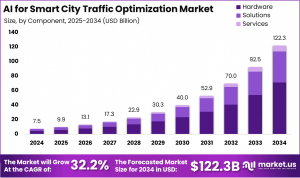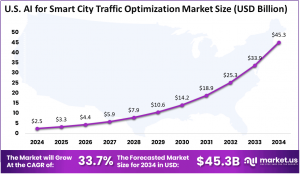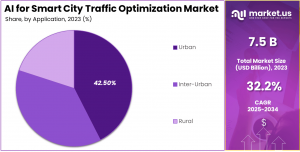In 2023, North America held a dominant market position in the global AI for Smart City Traffic Optimization Market, capturing more than a 38.5% share...
In 2024, the Urban Traffic Management & Control System segment held a dominant market position, capturing more than a 34.7% share of the Global AI for Smart City Traffic Optimization Market...”
NEW YORK, NY, UNITED STATES, February 21, 2025 /EINPresswire.com/ -- The AI for Smart City Traffic Optimization Market is projected to grow significantly from USD 7.5 billion in 2024 to USD 122.3 billion by 2034, with a robust CAGR of 32.2%. — Tajammul Pangarkar
This growth is spurred by the increasing adoption of AI technologies aimed at enhancing traffic flow, reducing congestion, and improving transportation infrastructure in urban areas. The integration of AI with smart city initiatives addresses the challenges posed by urbanization and a growing global population, fostering more efficient transportation systems.
🔴 𝐇𝐮𝐫𝐫𝐲 𝐄𝐱𝐜𝐥𝐮𝐬𝐢𝐯𝐞 𝐃𝐢𝐬𝐜𝐨𝐮𝐧𝐭 𝐅𝐨𝐫 𝐋𝐢𝐦𝐢𝐭𝐞𝐝 𝐏𝐞𝐫𝐢𝐨𝐝 𝐎𝐧𝐥𝐲 @ https://market.us/purchase-report/?report_id=138040
Key Takeaways:
In 2024, the Hardware segment captured more than a 58.2% market share, driven by its essential role in enabling real-time data processing for traffic management.
The Urban Traffic Management & Control System segment held over a 34.7% share, highlighting the demand for improved traffic solutions in densely populated areas.
With over 42.5% market share, the Urban segment underscores the critical need for AI to manage complex traffic networks in city settings.
These advancements are propelled by significant investments in AI and smart city projects, supported by public and private sector collaborations. The deployment of AI in traffic systems enhances efficiency and paves the way for broader adoption of smart infrastructures globally.
🔴 𝐃𝐢𝐫𝐞𝐜𝐭 𝐃𝐨𝐰𝐧𝐥𝐨𝐚𝐝 𝐄𝐱𝐜𝐥𝐮𝐬𝐢𝐯𝐞 𝐒𝐚𝐦𝐩𝐥𝐞 𝐨𝐟 𝐭𝐡𝐢𝐬 𝐏𝐫𝐞𝐦𝐢𝐮𝐦 𝐑𝐞𝐩𝐨𝐫𝐭 @ https://market.us/report/ai-for-smart-city-traffic-optimization-market/free-sample/
Experts Review
Government incentives and technological innovations play a pivotal role in advancing the AI for Smart City Traffic Optimization Market. In North America, especially in the U.S., federal grants and funding spur the adoption of smart traffic solutions, as seen with projects like Smart Columbus. Despite the high initial investment and implementation costs, long-term benefits incentivize cities to embrace AI technologies.
Opportunities abound with advancements in machine learning, IoT, and sensor technologies, transforming traditional traffic systems into intelligent networks capable of real-time traffic management and analytics. Emerging markets in Asia-Pacific present vast growth prospects due to rapid urbanization and infrastructure development.
However, challenges include ensuring data security and system reliability. AI systems must handle diverse variables, such as traffic volume and weather conditions, without fail. Compliance with regional regulations and standards is essential to mitigate risks associated with data breaches and ensure consistent system performance.
Overall, consumer awareness and technological impact on urban mobility drive the need for continuous innovation. Market participants must navigate regulatory environments and leverage cutting-edge technologies to sustain growth, enhance urban infrastructure, and meet the evolving demands of growing urban populations globally.
🔴 𝐃𝐢𝐫𝐞𝐜𝐭 𝐃𝐨𝐰𝐧𝐥𝐨𝐚𝐝 𝐄𝐱𝐜𝐥𝐮𝐬𝐢𝐯𝐞 𝐒𝐚𝐦𝐩𝐥𝐞 𝐨𝐟 𝐭𝐡𝐢𝐬 𝐏𝐫𝐞𝐦𝐢𝐮𝐦 𝐑𝐞𝐩𝐨𝐫𝐭 @ https://market.us/report/ai-for-smart-city-traffic-optimization-market/free-sample/
Report Segmentation
The AI for Smart City Traffic Optimization Market is segmented by component, system, and application to better understand its comprehensive landscape. By Component, the market comprises hardware, solutions, and services. Hardware, including sensors and surveillance cameras, is pivotal, capturing over 58.2% share due to its necessity for real-time data collection and processing.
Solutions encompass smart signaling and traffic analytics, crucial for efficient traffic management. This segment leverages AI to enhance urban transportation systems by optimizing route guidance and traffic flow.
By System, significant segments include Urban Traffic Management & Control Systems, holding a 34.7% share, driven by the need for efficient urban traffic solutions. These systems integrate advanced technologies like high-resolution cameras and machine learning to manage traffic patterns effectively.
By Application, the market is divided into urban, inter-urban, and rural segments, with urban areas leading with a 42.5% share. Urban segments face higher traffic density, necessitating advanced AI solutions for congestion management and traffic optimization.
This segmentation illustrates AI's pivotal role in transforming traffic management by offering scalable and adaptive solutions that cater to the diverse needs across different urban and rural environments, further demonstrating the market's potential for expansive growth and development.
🔴 𝐓𝐨 𝐆𝐚𝐢𝐧 𝐠𝐫𝐞𝐚𝐭𝐞𝐫 𝐢𝐧𝐬𝐢𝐠𝐡𝐭𝐬, 𝐑𝐞𝐪𝐮𝐞𝐬𝐭 𝐚 𝐬𝐚𝐦𝐩𝐥𝐞 𝐫𝐞𝐩𝐨𝐫𝐭 @ https://market.us/report/ai-for-smart-city-traffic-optimization-market/free-sample/
Drivers, Restraints, Challenges, and Opportunities
Drivers: Increasing urbanization and the proliferation of vehicles on the road drive the demand for smart city traffic optimization. AI technologies enable real-time traffic management, reducing congestion and improving mobility through dynamic traffic signal adjustments and route optimization.
Restraints: High implementation costs pose significant barriers to deploying AI-driven traffic systems, particularly in cities with limited budgets. The need for advanced hardware and continuous maintenance further elevates the financial burden on municipalities.
Challenges: Ensuring the reliability of AI systems is a major challenge. Traffic systems must accurately adapt to complex conditions including traffic volume and weather. Any malfunction could lead to significant disruptions, necessitating robust systems that can handle real-time data accurately.
Opportunities: The integration of AI with autonomous and electric vehicles presents lucrative growth opportunities. AI can enhance vehicle-to-infrastructure communication, optimizing traffic flow and minimizing delays. Additionally, AI's role in reducing emissions through efficient traffic management aligns with global sustainability goals.
These factors collectively influence the AI for Smart City Traffic Optimization Market, highlighting both the opportunities for innovative solutions and the challenges in achieving seamless implementation. Strategic investments and technological advancements will be crucial to overcoming these hurdles and realizing the full potential of AI in traffic optimization.
Key Player Analysis
Leading companies such as Cubic Corporation and Thales Group dominate the AI for Smart City Traffic Optimization Market by offering cutting-edge solutions for traffic management. Cubic Corporation specializes in AI-powered systems designed to improve traffic flow and minimize congestion. Their focus on integrating AI with urban infrastructures enhances their competitive edge.
Thales Group advances the market through its expertise in real-time traffic optimization, particularly within the air traffic management sector. By leveraging AI and big data, Thales ensures safe and efficient airspace management, which is increasingly critical in crowded urban skies.
These key players, along with others like Siemens AG and IBM, drive technological advancements and reshape the competitive landscape. Their contributions are pivotal in providing innovative AI solutions that address urban mobility challenges, enhance efficiency, and support the development of smarter cities worldwide. Their leadership in deploying AI-driven traffic systems underscores the market's dynamic potential for growth and transformation.
Recent Developments
Significant developments in the AI for Smart City Traffic Optimization Market underscore the sector’s dynamic growth. In March 2024, L&T collaborated with Intel to advance scalable edge-AI solutions, focusing on Cellular Vehicle-to-Everything (CV2X) applications. This partnership harnesses L&T’s expertise in smart transportation and Intel's edge computing capabilities.
Additionally, Thales Group expanded its partnership with Neural Labs, enhancing AI-driven Intelligent Transportation Systems (ITS) for secure and efficient urban mobility. This collaboration aims to deliver practical solutions for vehicle access control, logistics planning, and more.
In December 2023, Yunex Traffic launched an Advanced Traffic Management System (ATMS) in the U.S., utilizing cloud-based technology to optimize traffic management challenges efficiently. These initiatives reflect the industry's commitment to leveraging AI innovations to address complex traffic management needs, ensuring a safer, more efficient urban environment, and highlighting the aggressive push towards smarter cities.
Conclusion
The AI for Smart City Traffic Optimization Market is poised for significant expansion, driven by urbanization and technological advancements. While challenges such as high implementation costs and system reliability persist, opportunities abound in integrating AI with autonomous and electric vehicles. Key industry players continue to innovate, offering robust solutions to improve urban traffic systems.
As cities worldwide prioritize smarter infrastructure, AI-driven traffic optimization becomes essential for enhanced mobility and reduced congestion. With strategic investments and technological progress, the market is set to redefine urban transportation, paving the way for a more efficient, connected future.
➤ 𝐄𝐱𝐩𝐥𝐨𝐫𝐞 𝐎𝐭𝐡𝐞𝐫 𝐈𝐧𝐭𝐞𝐫𝐞𝐬𝐭𝐞𝐝 𝐓𝐨𝐩𝐢𝐜𝐬
Semiconductor Manufacturing Equipment Market - https://market.us/report/semiconductor-manufacturing-equipment-market/
E-Commerce Logistics Market - https://market.us/report/e-commerce-logistics-market/
Mail Order Pharmacy Market - https://market.us/report/mail-order-pharmacy-market/
Children Entertainment Centers Market - https://market.us/report/children-entertainment-centers-market/
Virtualized RAN (vRAN) Market - https://market.us/report/virtualized-ran-vran-market/
Semiconductor Rectifier Market - https://market.us/report/semiconductor-rectifier-market/
RFID Tags Market - https://market.us/report/rfid-tags-market/
Payment Processing Solution Market - https://market.us/report/payment-processing-solution-market/
Confidential Computing Market - https://market.us/report/confidential-computing-market/
Taxi App Market - https://market.us/report/taxi-app-market/
Quantum AI Market - https://market.us/report/quantum-ai-market/
Shooting and Gun Accessories Market - https://market.us/report/shooting-and-gun-accessories-market/
FinFET Technology Market - https://market.us/report/finfet-technology-market/
Virtual Reality in Tourism Market - https://market.us/report/virtual-reality-in-tourism-market/
Quantum Networking Market - https://market.us/report/quantum-networking-market/
Lawrence John
Prudour
+91 91308 55334
Lawrence@prudour.com
Visit us on social media:
Facebook
LinkedIn
Legal Disclaimer:
EIN Presswire provides this news content "as is" without warranty of any kind. We do not accept any responsibility or liability for the accuracy, content, images, videos, licenses, completeness, legality, or reliability of the information contained in this article. If you have any complaints or copyright issues related to this article, kindly contact the author above.




